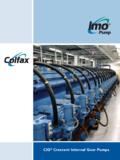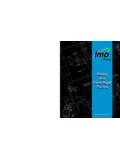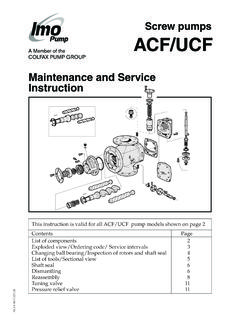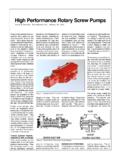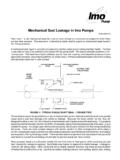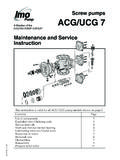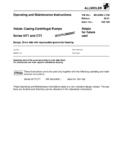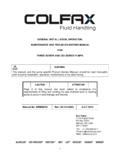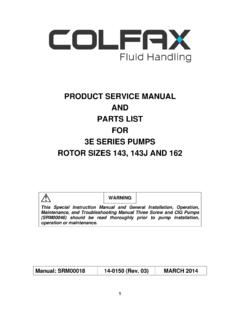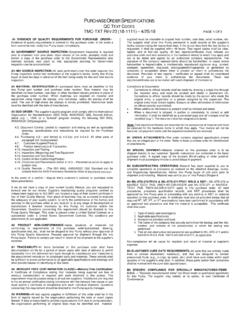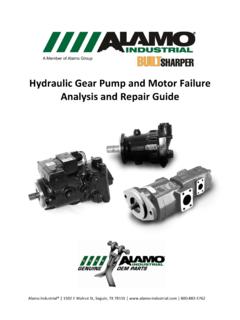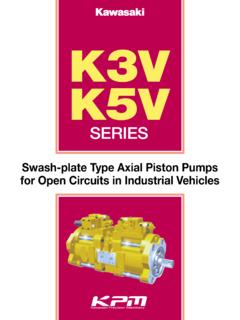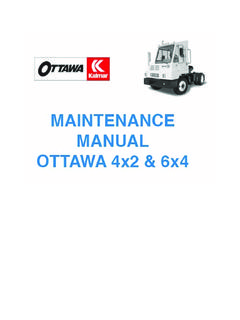Transcription of MAINTENANCE REDUCTION for LUBE OIL PUMPS
1 George Ponton MAINTENANCE REDUCTION for LUBE OIL PUMPS ABSTRACT The fleet is plagued with leaking lube oil PUMPS due to mechanical shaft seal failures. Correction programs have resulted in improved shaft sealing techniques however, there continues to be a leakage problem on most classes of ships. The ultimate solution is to eliminate the mechanical shaft seal. This has been proven to be a very successful solution and has additional benefits of eliminating the motor to pump coupling, which further reduces MAINTENANCE . The newly developed Canned Lube Oil Pump is the solution. It combines the proven screw pump design with the proven Oil-Through motor design.
2 The resulting compact pumping unit is substantially smaller and lighter than the legacy unit. The motor is cooled by a portion of the oil, that is being pumped to the system. This eliminates the motor cooling fan and eliminates grease packed motor bearings, further reducing MAINTENANCE . A comprehensive factory and shipboard testing program has demonstrated that this new unit will eliminate oil leaking from lube oil PUMPS , thus will reduce shipboard MAINTENANCE substantially. INTRODUCTION Lubricating Oil PUMPS for Naval Ships are designed in accordance with the requisite Military Specification [Mil-P-18547,1963]. That specification has always been invoked in Naval Shipbuilding Programs Top Level Specifications.
3 Thus all USN War Ships constructed in the last 40 years have PUMPS installed in accordance with that specification, as modified for the particular program. The PUMPS are positive displacement rotary screw PUMPS of two types: Timed (type II) and untimed (type III). The function of the PUMPS is to provide lubricating oil to the propulsion machinery for gearbox and turbine bearing lubrication and cooling. The fluid being pumped is turbine/ REDUCTION gear lubricating oil [Mil-L-17331, 1992], commonly called 2190 TEP. The fluid is used for Main REDUCTION Gear Lubrication on all Steam and Gas Turbine Powered Ships, and in some hydraulic systems. The requirement for mechanical shaft seals is stated in paragraph of the pump Military Specification [Mil-P-18547] as follows: Mechanical shaft seals shall be used in all PUMPS intended for installation on ships having nuclear powered propulsion plants and for installation on other ships when specified There are no other requirements stated for the seals, such as materials, types, installation, etc.
4 A mechanical shaft seal is defined as: A device designed to prevent the movement of fluid from one area to another, or to exclude contaminants [Fluid Sealing Association, 1990]. In a Lubricating Oil Pump its function is to prevent the lube oil being pumped from leaking along the power rotor shaft and into the Machinery Room. The mechanical shaft seal is mounted on the pump shaft and consists of a stationary sealing element and a rotating sealing element. These elements are also referred to as rings, faces and seats. The faces of the sealing elements have a very fine finish, measured in helium light bands. The faces are held in contact with a spring(s), which maintains pressure between the faces.
5 Figure 1 shows a typical Mechanical Shaft Seal as used in Lube Oil PUMPS to comply with the specification requirements. Fig. 1 Mechanical Shaft Seal Assembly SEAL LEAKS AND FAILURES Leaking Seals cause several problems including: - Increased MAINTENANCE cleaning up leaked oil - Hazardous conditions due to leaked oil - Housekeeping in disposal of oil soaked rags - Pier side costs involved with frequent seal replacement The first formal documentation of problems with Lube Oil PUMPS mechanical seals was a 1986 report [Failure Analysis of CG 47 Class Propulsion Lube Oil PUMPS ]. The report was basically a study of Lube Oil PUMPS Casualty reports (CASREPTS) and 3M data on several classes of surface combatants.
6 One significant statement in that report was: Mechanical Shaft Seal failures are the single largest cause of pump failure reported . Another significant report of the problems with Oil Pump seals was a 1987 study [Analysis of IMO Pump mechanical shaft seal removed from Trident Class submarines] certainly implied problems with seals. That report documented 42 seal failures over four years. The Trident Hydraulic PUMPS handle 2190 TEP the same fluid as Lube Oil PUMPS . Unfortunately, the recommendations of that report were erroneous and suggested materials that are unsatisfactory with respect to seal face materials. During this same time frame Naval Sea Systems Command [NAVSEA] established requirements for mechanical seals for Navy PUMPS .
7 In a memo that was issued in 1986 [SER 56Y21/267] several mechanical seal requirements were addressed including: Alternate Manufacturers, Backup Packing, Materials, Positioning, Liquid pressure and Circulation. This was a step in the right direction, the real goal being REDUCTION in the number of different seals with which the Navy had to contend. The downside of this directive was it addressed centrifugal pump seals (water service) as if they were interchangeable with positive displacement pump seals (lube oil). This memo also excluded the face materials that have the best results with 2190 TEP. Serious Seal leaks occurred when the Main Lube Oil PUMPS for a new support ship were operated at the building yard.
8 These were the first Lube Oil PUMPS that utilized seals in accordance with the NAVSEA guidance memo [SER 56Y21/267]. So by the end of the 80 s it was well documented that the Mechanical Seal leakage/failure problem was getting worse, not better. Discussions involving allowable seal leaks ranged from 5 drops per hour to 5 drops per minute. What needed to be addressed was how to eliminate seal leaks so the criteria could become ZERO leakage. Vertical Lube Oil Pump Seal Leak Investigation In 1994 when the first ship of a new class of Combat Support Ships was nearing delivery, the Main Lube Oil PUMPS were a source of serious oil leakage. The mechanical shaft seals were failing during operational testing of the Lube Oil System.
9 The factory investigated the PUMPS still at the manufacturer, that were slated for delivery to a later ship of the class. These were the first PUMPS designed with the mechanical shaft seals per the new directive [SER 56Y21/267] which required tungsten carbide or silicon carbide stationary seats and F91 Carbon rotating seats. The Mechanical seal installed in the Vertical Lube Oil Pump was a Type 21 Seal with a Tungsten Carbide stationary seat and a F91 carbon rotating seat. The stationary seat utilized an O-ring. The design was reviewed to verify that seal chamber design was proper for a 2 inch size seal including working length, PV limit, cooling flow, pressure, and venting.
10 The seal arrangement/installation was also reviewed to verify proper procedures were being followed for installation and operation. The viscosity characteristics of 2190 TEP oil were also reviewed. This oil has a viscosity range from 100 SSU to 4000 SSU, as shown in Figure 2. 4000250053010005001000150020002500300035 0040004500020406080100120140160180 Temperature Degrees FViscosity SSU -(40 )(55 )(90 )(160 ) Fig. 2 Viscosity of 2190 TEP Since the design and installation were determined to be proper, a test program was initiated to obtain technical information as to the cause(s) of seal failures. This included a thermal couple installed in the stationary seat to measure the seal face temperature.
